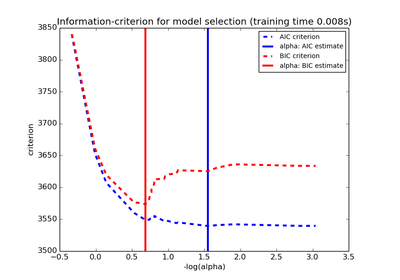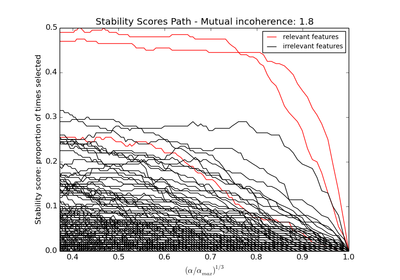3.2.4.1.4. sklearn.linear_model.LassoLarsCV¶
- class sklearn.linear_model.LassoLarsCV(fit_intercept=True, verbose=False, max_iter=500, normalize=True, precompute='auto', cv=None, max_n_alphas=1000, n_jobs=1, eps=2.2204460492503131e-16, copy_X=True)[source]¶
Cross-validated Lasso, using the LARS algorithm
The optimization objective for Lasso is:
(1 / (2 * n_samples)) * ||y - Xw||^2_2 + alpha * ||w||_1
Parameters: fit_intercept : boolean
whether to calculate the intercept for this model. If set to false, no intercept will be used in calculations (e.g. data is expected to be already centered).
verbose : boolean or integer, optional
Sets the verbosity amount
normalize : boolean, optional, default False
If True, the regressors X will be normalized before regression.
precompute : True | False | ‘auto’ | array-like
Whether to use a precomputed Gram matrix to speed up calculations. If set to 'auto' let us decide. The Gram matrix can also be passed as argument.
max_iter : integer, optional
Maximum number of iterations to perform.
cv : cross-validation generator, optional
see sklearn.cross_validation module. If None is passed, default to a 5-fold strategy
max_n_alphas : integer, optional
The maximum number of points on the path used to compute the residuals in the cross-validation
n_jobs : integer, optional
Number of CPUs to use during the cross validation. If -1, use all the CPUs
eps : float, optional
The machine-precision regularization in the computation of the Cholesky diagonal factors. Increase this for very ill-conditioned systems.
copy_X : boolean, optional, default True
If True, X will be copied; else, it may be overwritten.
Attributes: coef_ : array, shape (n_features,)
parameter vector (w in the formulation formula)
intercept_ : float
independent term in decision function.
coef_path_ : array, shape (n_features, n_alphas)
the varying values of the coefficients along the path
alpha_ : float
the estimated regularization parameter alpha
alphas_ : array, shape (n_alphas,)
the different values of alpha along the path
cv_alphas_ : array, shape (n_cv_alphas,)
all the values of alpha along the path for the different folds
cv_mse_path_ : array, shape (n_folds, n_cv_alphas)
the mean square error on left-out for each fold along the path (alpha values given by cv_alphas)
n_iter_ : array-like or int
the number of iterations run by Lars with the optimal alpha.
Notes
The object solves the same problem as the LassoCV object. However, unlike the LassoCV, it find the relevant alphas values by itself. In general, because of this property, it will be more stable. However, it is more fragile to heavily multicollinear datasets.
It is more efficient than the LassoCV if only a small number of features are selected compared to the total number, for instance if there are very few samples compared to the number of features.
Methods
decision_function(X) Decision function of the linear model. fit(X, y) Fit the model using X, y as training data. get_params([deep]) Get parameters for this estimator. predict(X) Predict using the linear model score(X, y[, sample_weight]) Returns the coefficient of determination R^2 of the prediction. set_params(**params) Set the parameters of this estimator. - __init__(fit_intercept=True, verbose=False, max_iter=500, normalize=True, precompute='auto', cv=None, max_n_alphas=1000, n_jobs=1, eps=2.2204460492503131e-16, copy_X=True)[source]¶
- decision_function(X)[source]¶
Decision function of the linear model.
Parameters: X : {array-like, sparse matrix}, shape = (n_samples, n_features)
Samples.
Returns: C : array, shape = (n_samples,)
Returns predicted values.
- fit(X, y)[source]¶
Fit the model using X, y as training data.
Parameters: X : array-like, shape (n_samples, n_features)
Training data.
y : array-like, shape (n_samples,)
Target values.
Returns: self : object
returns an instance of self.
- get_params(deep=True)[source]¶
Get parameters for this estimator.
Parameters: deep: boolean, optional :
If True, will return the parameters for this estimator and contained subobjects that are estimators.
Returns: params : mapping of string to any
Parameter names mapped to their values.
- predict(X)[source]¶
Predict using the linear model
Parameters: X : {array-like, sparse matrix}, shape = (n_samples, n_features)
Samples.
Returns: C : array, shape = (n_samples,)
Returns predicted values.
- score(X, y, sample_weight=None)[source]¶
Returns the coefficient of determination R^2 of the prediction.
The coefficient R^2 is defined as (1 - u/v), where u is the regression sum of squares ((y_true - y_pred) ** 2).sum() and v is the residual sum of squares ((y_true - y_true.mean()) ** 2).sum(). Best possible score is 1.0, lower values are worse.
Parameters: X : array-like, shape = (n_samples, n_features)
Test samples.
y : array-like, shape = (n_samples) or (n_samples, n_outputs)
True values for X.
sample_weight : array-like, shape = [n_samples], optional
Sample weights.
Returns: score : float
R^2 of self.predict(X) wrt. y.
- set_params(**params)[source]¶
Set the parameters of this estimator.
The method works on simple estimators as well as on nested objects (such as pipelines). The former have parameters of the form <component>__<parameter> so that it’s possible to update each component of a nested object.
Returns: self :



